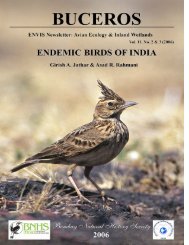Untitled - ENVIS Centre on Avian Ecology
Untitled - ENVIS Centre on Avian Ecology
Untitled - ENVIS Centre on Avian Ecology
Create successful ePaper yourself
Turn your PDF publications into a flip-book with our unique Google optimized e-Paper software.
projected, in any of: (a) extent of occurrence; (b) area of<br />
occupancy; (c) area, extent and/or quality of habitat; (d)<br />
number of locati<strong>on</strong>s or subpopulati<strong>on</strong>s; (e) number of<br />
mature individuals; (3) extreme fluctuati<strong>on</strong>s in any of:<br />
(a) extent of occurrence; (b) area of occupancy; (c)<br />
number of locati<strong>on</strong>s or subpopulati<strong>on</strong>s; (d) number of<br />
mature individuals;<br />
C – populati<strong>on</strong> estimated to number less than 2,500<br />
mature individuals and either:<br />
(1) an estimated c<strong>on</strong>tinuing decline of at least 20%<br />
within 5 years or 2 generati<strong>on</strong>s, whichever is l<strong>on</strong>ger, or<br />
(2) a c<strong>on</strong>tinuing decline, observed, projected or<br />
inferred, in numbers of mature individuals and<br />
populati<strong>on</strong> structure in the form of either: (a) severely<br />
fragmented (i.e. no subpopulati<strong>on</strong> estimated to c<strong>on</strong>tain<br />
more than 250 mature individuals); (b) all individuals<br />
in a single subpopulati<strong>on</strong>;<br />
D – populati<strong>on</strong> estimated to number less than 250<br />
mature individuals;<br />
E – quantitative analysis showing the probability<br />
of extincti<strong>on</strong> in the wild is at least 20% within 20 years<br />
or 5 generati<strong>on</strong>s, whichever is the l<strong>on</strong>ger.<br />
Vulnerable (VU): A tax<strong>on</strong> is Vulnerable when it<br />
is not Critically Endangered or Endangered but is facing<br />
a high risk of extincti<strong>on</strong> in the wild in the medium-term<br />
future, as defined by any of the following criteria (A to<br />
E):<br />
A – populati<strong>on</strong> reducti<strong>on</strong> in the form of either:<br />
(1) an observed, estimated, inferred or suspected<br />
reducti<strong>on</strong> of at least 20% over the last 10 years or 3<br />
generati<strong>on</strong>s, whichever is the l<strong>on</strong>ger, based <strong>on</strong> (and<br />
specifying) any of: (a) direct observati<strong>on</strong>; (b) an index<br />
of abundance appropriate for the tax<strong>on</strong>; (c) a decline in<br />
area of occupancy, extent of occurrence and/or quality<br />
of habitat; (d) actual or potential levels of exploitati<strong>on</strong>;<br />
(e) the effects of introduced taxa, hybridisati<strong>on</strong>,<br />
pathogens, pollutants, competitors or parasites;<br />
(2) a reducti<strong>on</strong> of at least 20%, projected or<br />
suspected to be met within the next 10 years or 3<br />
generati<strong>on</strong>s, whichever is the l<strong>on</strong>ger, based <strong>on</strong> (and<br />
specifying) any of (b), (c), (d) or (e) above;<br />
B – extent of occurrence estimated to be less<br />
than 20,000 sq. km or area of occupancy estimated to be<br />
less than 2,000 km 2 , and estimates indicating any two<br />
of:<br />
(1) severely fragmented or known to exist at no<br />
more than ten locati<strong>on</strong>s;<br />
(2) c<strong>on</strong>tinuing decline, inferred, observed or<br />
Buceros Vol. 7, No. 1 & 2 (2002)<br />
projected, in any of: (a) extent of occurrence; (b) area<br />
of occupancy; (c) area, extent and/or quality of habitat;<br />
(d) number of locati<strong>on</strong>s or subpopulati<strong>on</strong>s; (e) number<br />
of mature individuals;<br />
(3) extreme fluctuati<strong>on</strong>s in any of: (a) extent of<br />
occurrence; (b) area of occupancy; (c) number of<br />
locati<strong>on</strong>s or subpopulati<strong>on</strong>s; (d) number of mature<br />
individuals;<br />
C – populati<strong>on</strong> estimated to number less than<br />
10,000 mature individuals and either:<br />
(1) an estimated c<strong>on</strong>tinuing decline of at least 10%<br />
within 10 years or 3 generati<strong>on</strong>s, whichever is l<strong>on</strong>ger,<br />
or<br />
(2) a c<strong>on</strong>tinuing decline, observed, projected or<br />
inferred, in numbers of mature individuals and<br />
populati<strong>on</strong> structure in the form of either: (a) severely<br />
fragmented (i.e. no subpopulati<strong>on</strong> estimated to c<strong>on</strong>tain<br />
more than 1,000 mature individuals); (b) all individuals<br />
in a single subpopulati<strong>on</strong>;<br />
D – populati<strong>on</strong> very small or restricted in the form<br />
of either of:<br />
(1) populati<strong>on</strong> estimated to number less than 1,000<br />
mature individuals;<br />
(2) populati<strong>on</strong> characterised by acute restricti<strong>on</strong><br />
in its area of occupancy (typically less than 100 km 2 )<br />
or in the number of locati<strong>on</strong>s (typically less than 5);<br />
E – quantitative analysis showing the probability<br />
of extincti<strong>on</strong> in the wild is at least 10% within 100<br />
years.<br />
Lower Risk (LR): A tax<strong>on</strong> is Lower Risk when it<br />
has been evaluated but does not satisfy the criteria for<br />
any of the categories Critically Endangered, Endangered<br />
or Vulnerable. Taxa included in the Lower Risk category<br />
can be separated into three subcategories: 1. C<strong>on</strong>servati<strong>on</strong><br />
Dependent (CD): taxa which are the focus of a c<strong>on</strong>tinuing<br />
tax<strong>on</strong>-specific or habitat-specific c<strong>on</strong>servati<strong>on</strong><br />
programme targeted towards the tax<strong>on</strong> in questi<strong>on</strong>, the<br />
cessati<strong>on</strong> of which would result in the tax<strong>on</strong> qualifying<br />
for <strong>on</strong>e of the threatened categories above within a period<br />
of five years; 2. Near Threatened (NT): taxa which do<br />
not qualify as C<strong>on</strong>servati<strong>on</strong> Dependent, but which are<br />
close to qualifying as Vulnerable; 3. Least C<strong>on</strong>cern (LC):<br />
taxa which do not qualify as C<strong>on</strong>servati<strong>on</strong> Dependent or<br />
Near Threatened.<br />
Data Deficient (DD): A tax<strong>on</strong> is Data Deficient<br />
when there is inadequate informati<strong>on</strong> to make a direct,<br />
or indirect, assessment of its risk of extincti<strong>on</strong> based <strong>on</strong><br />
its distributi<strong>on</strong> and/ or populati<strong>on</strong> status. A tax<strong>on</strong> in this<br />
9 THREATENED BIRDS OF INDIA




